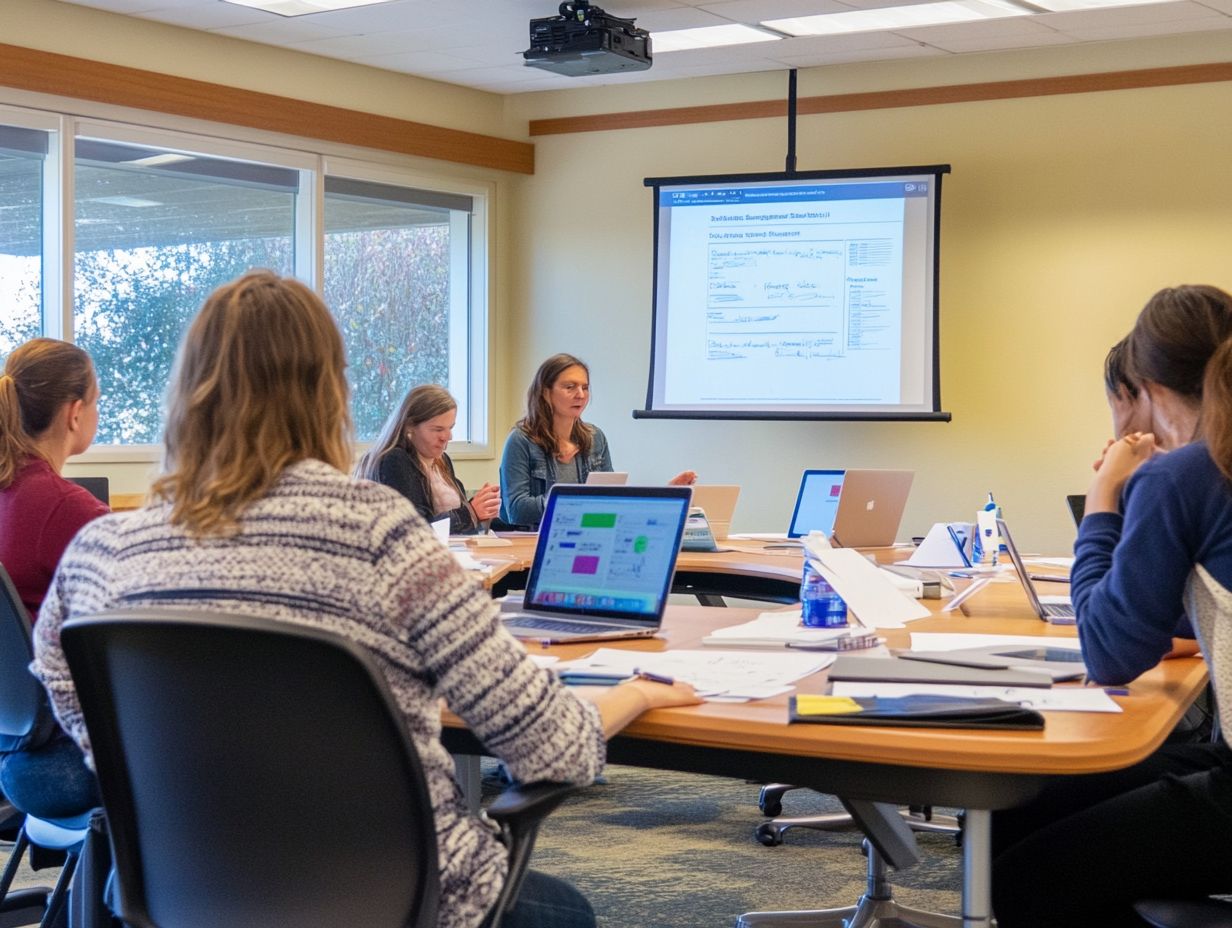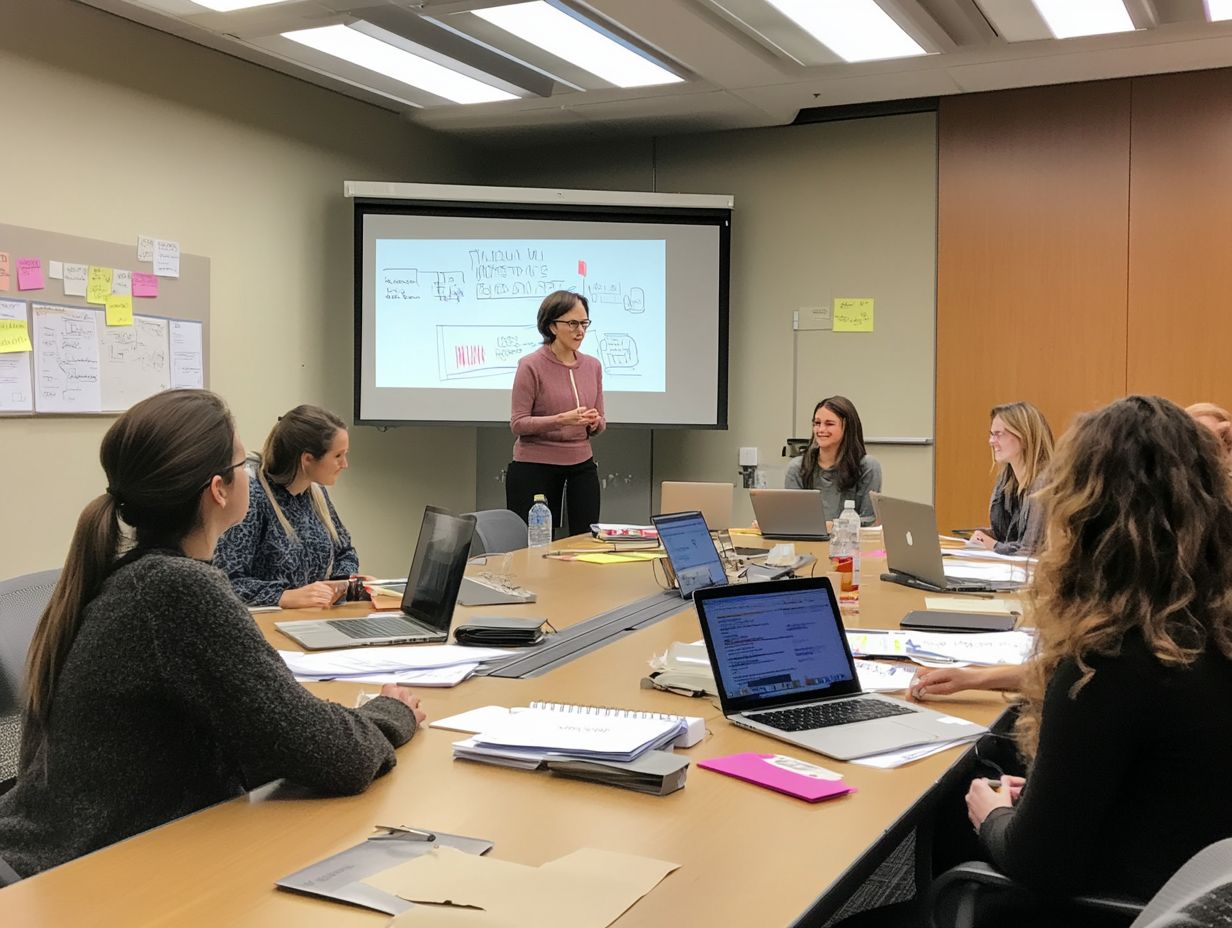How to Incorporate Feedback into Training Programs?
In today s fast-paced learning environments, you ll find that effective training programs rely on one crucial element: feedback!
Feedback not only enriches understanding but also cultivates growth and improvement. This article delves into the essential role feedback plays in training, covering various types and methods of gathering it, as well as strategies for effective implementation.
You will also discover how to handle negative feedback constructively and measure its impact on learning. Together, let s explore how to harness feedback to drive continuous improvement in your training initiatives!
Contents
- Key Takeaways:
- The Importance of Feedback in Training Programs
- Types of Feedback
- How to Gather Feedback
- Incorporating Feedback into Training Programs
- Measuring the Effectiveness of Feedback
- Addressing Negative Feedback
- Continuous Improvement through Feedback
- Frequently Asked Questions
- 1. How can feedback be incorporated into training programs?
- 2. Why is incorporating feedback important in training programs?
- 3. What are some methods for collecting feedback in training programs?
- 4. How should feedback be analyzed and utilized in training programs?
- 5. How can trainers encourage participants to provide feedback?
- 6. What are some challenges in incorporating feedback into training programs?
Key Takeaways:

- Feedback is essential for effective learning in training programs.
- There are various forms of feedback, including verbal, written, and visual, that can be used to enhance training.
- Strategically incorporating feedback and evaluating its impact can lead to continuous improvement in training programs.
The Importance of Feedback in Training Programs
Feedback is crucial for elevating the effectiveness of your employee training programs. It cultivates a culture of continuous improvement that significantly enhances employee engagement and satisfaction.
By implementing strong feedback loops systems that allow ongoing input and responses you can ensure that training sessions are meticulously tailored to address the unique needs of your team, fostering a performance culture that prioritizes ongoing development.
Effective feedback methods sharpen the training content and align your training objectives with organizational goals, ultimately resulting in higher employee retention and enhanced overall performance.
Why Feedback is Essential for Learning
Feedback is essential for your learning journey, offering timely insights that help you grasp your strengths and pinpoint areas for improvement. This ultimately enriches your overall experience.
By engaging in a two-way dialogue, you have the opportunity to refine your communication skills as you observe the reactions and responses of your peers and trainers. Incorporating interactive elements into training programs cultivates a more dynamic exchange, enabling you not only to express your thoughts but also to actively listen and adapt based on constructive criticism.
This fluid communication process is vital; the effectiveness of both giving and receiving feedback nurtures a culture of continuous improvement. In this environment, you are given the power to evolve and excel in your role.
Types of Feedback
Grasping the various types of feedback is essential for enhancing employee training. This understanding gives the power to trainers to choose the most suitable feedback methods that truly resonate with participants and align with training objectives.
Different Forms of Feedback and Their Uses
Different forms of feedback, such as feedback surveys and automated workflows, each serve unique purposes in enhancing participant engagement and cultivating a robust feedback culture.
When you utilize real-time surveys, you re able to capture immediate reactions and insights during training sessions. This allows you to make on-the-fly adjustments that elevate the learning experience.
Feedback surveys, in contrast, offer a structured method to gather comprehensive evaluations after the program wraps up, giving participants the chance to reflect on what they ve learned and how they can apply that knowledge.
By integrating these tools, you can foster a dynamic environment where input is genuinely valued. This approach leads to continuous improvement and boosts motivation among learners. A thriving feedback culture not only addresses participants’ needs but also gives the power to them to take ownership of their learning journey.
How to Gather Feedback

Gathering feedback effectively is crucial for the success of any training program. Doing so offers valuable insights into the participant experience and the overall effectiveness of the training, allowing for continuous improvement and refinement.
Methods for Collecting Feedback
A variety of methods for collecting feedback, including real-time surveys and tools that help gather feedback automatically, can significantly enhance the effectiveness of your training evaluations and overall engagement strategies.
By utilizing these tools, you can gather insights directly from participants, fostering a more interactive and responsive environment. For example, these tools can streamline the feedback collection process, ensuring that responses are organized and analyzed efficiently. Conducting feedback surveys after training sessions provides you with valuable data on participant satisfaction and highlights areas that may need improvement.
By integrating these strategies, you not only elevate engagement but also cultivate a culture of continuous learning, empowering trainers to adapt their methods to better meet the needs of their audience.
Incorporating Feedback into Training Programs
Incorporating feedback into your training programs is essential for cultivating a feedback culture that enhances employee engagement and drives performance improvements. Learning how to use feedback for training improvement can lead to more effective strategic implementation.
By prioritizing this process, you set the stage for a more dynamic and responsive work environment, empowering individuals to thrive and contribute meaningfully to the organization’s success.
Strategies for Implementing Feedback
To effectively implement feedback, you can leverage the person leading the training while promoting engagement strategies that encourage constructive criticism, all aimed at aligning with your training objectives.
A skilled facilitator is essential in creating a safe environment where everyone feels valued and heard, fostering a culture that truly embraces feedback. This involves actively modeling constructive communication and showing participants how to offer specific, actionable suggestions instead of vague critiques.
By establishing ground rules for respectful dialogue, the facilitator can steer conversations that focus on learning and growth. Regular feedback loops help participants understand their progress and nurture leadership competencies by encouraging individuals to take ownership of their development.
This alignment boosts both personal development and the organization s success, significantly enhancing overall effectiveness.
Measuring the Effectiveness of Feedback
Measuring the effectiveness of feedback is essential for grasping its impact on training outcomes and overall employee satisfaction. It offers valuable insights that pave the way for continuous improvement.
Evaluating the Impact of Feedback on Learning

Evaluating the impact of feedback on learning outcomes is crucial for cultivating a culture of continuous improvement and supporting your employees development within the organization.
By systematically applying training evaluations, you gain valuable insights into how effectively the feedback provided enhances the skills and knowledge of participants. This process reveals areas ripe for further growth and reinforces a performance-driven environment where employees are inspired to strive for excellence.
It enables you to identify which strategies yield the best results, allowing for a more tailored approach to training. Ultimately, this contributes to the development of a robust framework that promotes ongoing professional growth and aligns seamlessly with the organization s broader objectives for sustained success.
Addressing Negative Feedback
Addressing negative feedback is an essential skill that empowers you to cultivate a positive feedback culture and elevate communication skills among both employees and leaders.
By mastering this art, you not only enhance interpersonal dynamics but also create an environment where constructive dialogue thrives.
Dealing with Criticism in a Constructive Way
Dealing with criticism constructively means recognizing the immense value of helpful feedback and implementing effective mechanisms that promote employee development.
By adopting a perspective that views feedback not as a personal affront but as an avenue for growth, you can turn negative comments into valuable insights. This transformation is greatly enhanced by engagement strategies that encourage open dialogue, allowing team members to express their thoughts and observations in a secure environment.
Such practices cultivate trust and establish a culture that focuses on high performance, where constructive criticism is actively sought and genuinely appreciated. Nurturing a performance-oriented culture relies on reinforcing these practices, empowering team members to leverage feedback as a springboard for improvement and innovation.
Continuous Improvement through Feedback
Continuous improvement through feedback is crucial for ensuring that your training programs stay relevant and effective, in sync with evolving training objectives and the culture of organizational performance.
By actively seeking input and making adjustments, you can create a dynamic learning environment that meets the needs of both the participants and the organization as a whole.
Using Feedback to Improve Training Programs
Get ready to transform your training programs! Leveraging feedback to enhance your training can significantly boost participant engagement and elevate employee retention rates through tailored training activities.
By systematically collecting insights from participants, you can pinpoint areas where the training may be lacking or excelling, empowering you to make informed adjustments. This iterative process refines the content and delivery of your training while cultivating a culture of openness, where employees feel genuinely valued.
Involving employees in this feedback loop encourages them to take ownership of their learning journey, ultimately fostering greater motivation and commitment to their professional development. When your training initiatives align with the real needs and preferences of employees, they become more relevant and impactful, driving engagement and reducing turnover.
Frequently Asked Questions
Below are some common questions about incorporating feedback into training programs. Understanding how to use surveys to improve training programs can help you maximize the effectiveness of your training initiatives!

1. How can feedback be incorporated into training programs?
- Feedback can be incorporated in various ways, such as through surveys, evaluations, and one-on-one discussions with participants.
- Gather feedback throughout the training process to make necessary adjustments and improvements.
2. Why is incorporating feedback important in training programs?
- Incorporating feedback allows for a more effective and relevant training experience for participants.
- It also helps identify areas for improvement and ensures the program meets learners’ needs.
3. What are some methods for collecting feedback in training programs?
- Methods include surveys, evaluations, focus groups, and individual interviews.
- Choose the method that best fits the training program and its objectives.
4. How should feedback be analyzed and utilized in training programs?
- Feedback should be carefully analyzed to make necessary changes and improvements.
- Consider all feedback and identify common themes or areas for improvement.
5. How can trainers encourage participants to provide feedback?
- Trainers can encourage feedback by creating a safe and open learning environment.
- Emphasize the importance of feedback and provide multiple avenues for sharing thoughts and opinions.
6. What are some challenges in incorporating feedback into training programs?
- Challenges include interpreting and analyzing feedback, addressing negative feedback, and balancing the needs of different participants.
- It is important for trainers to be open-minded and adaptable when incorporating feedback.






